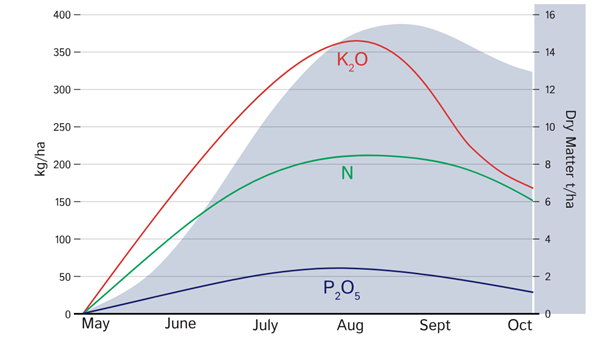Nutrition of Maize
April 2025
With soil temperatures increasing and moisture looming (or already arrived) thoughts are turning to maize drilling. To produce a good crop, maize plants need to grow very rapidly once they have germinated. They will do this if the soil moisture and structure are good, the temperature is warm and nutrition is adequate. Maize can easily produce 50 t/ha in a period of four months. To support this rapid growth it has a large demand for nutrients and any shortage will restrict early growth and final yield.

Phosphorus (P) is required particularly by the growing tips of the plant, hence its importance for root growth. Any shortage, especially in the very early stages, reduces root growth and nutrient uptake and this can adversely affect the growth of the crop for the rest of the season. Typical phosphate removal is 1.4 kg P2O5/t fresh crop, that is 55 kg/ha P2O5 for an average 40 t/ha forage crop.
Potash (Potassium, K) has several diverse roles in plants. It plays an important role in regulating the water content of the plant and with an adequate supply of K plants can survive drought stress more easily. It plays a major role in maintaining the turgor (i.e. rigidity) of plant tissue. Leaves need to be turgid to remain fully extended to maximise the surface exposed to sunlight that provides the energy to convert carbon dioxide in the atmosphere to sugars in the leaves. Plants well supplied with K also seem to be less susceptible to fungal and pest attacks.
Potassium is the nutrient required in the greatest amount by maize. An average 40 t/ha crop takes up around 360 kg/ha K2O by early August. The demand for potash is particularly large in the period of rapid growth and the crop needs to take up about 8 kg/ha K2O per day. The soil must be able to supply both the total demand of 360 kg/ha and the daily requirement of 8 kg/ha without any hindrance. This requires an adequate level of readily plant available soil potassium.
Maize grown for grain will have a much lower offtake than silage, due to the timing of the removal, and the amount of material that is removed from the field. The offtakes for grain maize will be similar to those for cereal grain removals found in the AHDB Nutrient Management Guide.
Magnesium (Mg) is an essential element in chlorophyll and hence for photosynthesis. Crop removal is 40 kg/ha MgO. The total requirement (to be supplied from manure and fertiliser) should be related to Mg level in the soil and additional Mg is only justified at soil Index 0 when 50-100 kg MgO/ha should be applied every 3-4 years. If both potash and magnesium soil levels are below the optimum, then apply the larger amount (100 kg MgO/ha).
Sulphur (S) is a constituent of protein together with nitrogen and the supplies of these nutrients in plants are highly inter-related. Studies have shown that one nutrient will accumulate in plants when the other is deficient, and when this deficiency is corrected the accumulated nutrient is then used in protein synthesis. Therefore, a shortage in the availability of sulphur will reduce the efficiency of nitrogen use. Sulphur deficiencies are possible in areas where the soil sulphur level is below optimum. Sulphur is applied in animal manures, but much of this is unavailable.
For more details see the PDA Leaflet 17 – Forage Maize

